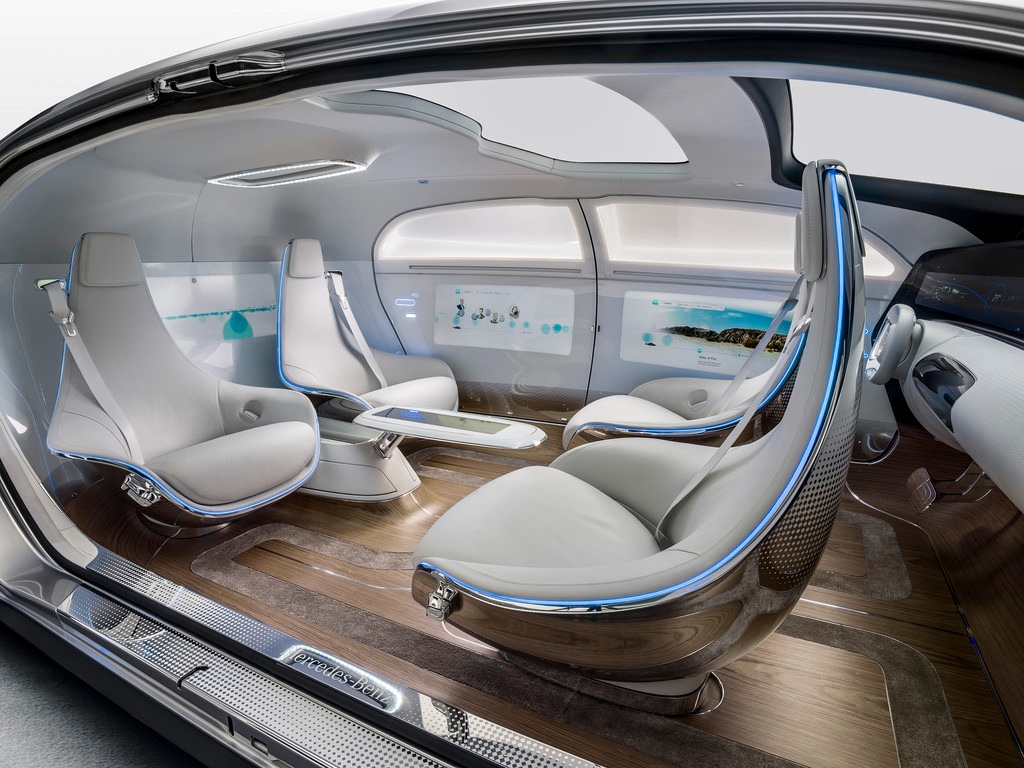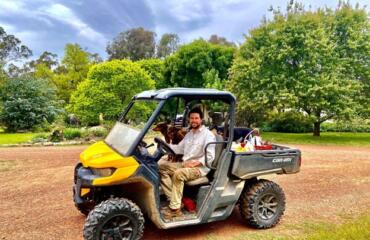
Look, no hands: inside the Mercedes-Benz F 015 ‘Luxury in Motion’ driverless car. PIC: Mercedes-Benz, via Flickr
Just imagine, the suburban garage is a thing of the past, that parents no longer drive their children to school and the peak-hour commute is on a bus without a driver.
Trips to a mechanic and the petrol station are no longer necessary. And the family home resembles something more akin to those of early last century – before private car ownership transformed cities and the lives of those who inhabited them.
This might seem far-fetched. But Tim Peggie, the director of regions for the Victorian Planning Authority, believes a future of driverless — or autonomous — vehicles, and seamless and safer travel, is closer than we might think. And the implications are vast.
“When the traditional driver-operated car emerged in the early 1900s, it completely changed not only the way we live but the buildings we live in,” he says.
“In the 1920s, there would have been more people riding bikes than driving cars, but that changed quickly. So what happens from now is a big question and with new technology there’s always a rapid rate of change. When [change] happens, it happens really fast.”

From Boston in the US to Wuhu, China, cities across the globe are championing driverless vehicles as a means of improving road safety, access, affordability and efficiency.
But some authorities, including those in Chicago, remain wary, fearing that driverless vehicles could threaten pedestrian safety, while in New York taxi owners are urging the city to ban them for 50 years, arguing such technology threatens to wipe out thousands of transport jobs.
The Victorian Government, meanwhile, is generally optimistic. State Roads Minister Luke Donnellan believes driverless vehicles will help reduce traffic congestion, improve mobility, increase efficiency and, most importantly, improve road safety.

The state government is working with German engineering and electrionics giant Bosch, the Transport Accident Commission and VicRoads to build Australia’s first vehicle with self-driving capabilities.
“This self-driving car is at the forefront of automated vehicle technology,” Mr Donnellan announced last year. “By removing human error from the equation, self-driving vehicles will play a critical role in reducing deaths and serious injuries on Victorian roads.”
Government bodies such as the Victorian Planning Authority and Infrastructure Victoria are also supportive.

“We’re quite optimistic about driverless vehicles,” says VicRoads’ director of future transport, Stuart Ballingall. “We think it’s possible we’ll see improvements in road safety as driverless vehicles have proven to be more safe than driver-operated vehicles.”
VicRoads and its partners are already trialling driverless technologies on Eastlink, testing how well the technology responds to road conditions such as signage and lane markings, as well as traffic.
Mr Ballingall says the tests will help better inform authorities on how the technology should be used and regulated.
But he acknowledges that no-one yet knows how driverless cars will ultimately impact a sprawling metropolis the size of Melbourne.
What is unclear is how such technology might alter the mix of private and public transport. For example, might it lead to an expansion of shared transportation, with state-owned driverless vehicles more easily plugging public transport gaps in outer suburbs? Could communities share vehicles in the same way that mini-buses currently service different groups? Would there be more – or less – private vehicle ownership? More – or less – congestion?
The VPA’s Mr Peggie admits Victoria’s plan for driverless vehicles is in its infancy.
“In the 1920s, there would have been more people riding bikes than driving cars, but that changed quickly. So what happens from now is a big question and with new technology there’s always a rapid rate of change. When [change] happens, it happens really fast.” — Tim Peggie, the Victorian Planning Authority
But he is confident the government is capable of responding to the challenges that driverless vehicles pose, and says Victoria has the road network to support the new technology.
He believes one of the clear and immediate advantages of driverless vehicles will be their ability to communicate with each other through their own GPS systems. Vehicles would be able to co-ordinate traffic flows by prioritising lanes, meaning passenger needs are catered for more efficiently.
“It’s frustrating sitting at an intersection and seeing 10 cars pass you and wondering why the intersection isn’t serving all cars at the same time,” Mr Peggie says. “Because driverless cars will all have a GPS fitted, they will be able to recognise when a chunk of traffic isn’t getting the priority it should.”
Such a system would also allow cars to maintain a constant distance from one another, meaning fewer accidents and traffic jams.
While the state government supports driverless vehicles, its primary focus is on the new technology’s obvious impact on Victoria’s roads system.
Mr Peggie argues driverless vehicles won’t just shape how we use transport but, ultimately, the way Melbourne functions more broadly and how Melburnians live.
He believes that a shift towards driverless public transport would mean the end of the suburban garage, no longer an essential annexe of the family home. In turn, this would change radically house design and functionality.

“If you travel to the outer suburbs, there’s often an enormous garage with a house attached. But if a bus or a car can come to people, they won’t need the garage. So the way we think about houses in Australia could dramatically change.
“House design responded to the growth of the manually-driven car. But if we change the way we approach transport, it’s going to change how we live and build. Getting rid of garages would mean building construction in the outer suburbs would become more efficient, and Victorian-style housing – without a garage or driveway – would make a comeback.”
The “back-to-the-future” image suggests that with pooled driverless vehicles collecting and delivering people – to and from work and school, and for shopping and functions – big city car parks would be rendered obsolete. Instead, cars would be stored in local car parks, where each section of the city would have its own dedicated fleet of driverless vehicles.
Mr Peggie believes the outer suburbs could stand to benefit the most from such a development, where commuters who are currently constrained by Melbourne’s hub-and-spoke rail network and patchy bus routes, could more easily criss-cross the city. Driverless public buses and cars could operate on a booking system, allowing commuters to book their trip, making public transport more user friendly. Buses would be able to respond to demand.
Of course, such predictions presume that private car ownership would fall as governments and society embrace a public model of driverless vehicles – a network of publicly-owned buses, trains, trams and cars.
This would demand a seismic cultural shift in how Australians view the car. Movies such as Wogboy and The cars that ate Paris underscore the importance of car ownership in Australian society.
But many Australians, particularly millennials, appear less interested in car ownership than in the past with car sharing sites such as Go-Get and Flexi-Car flourishing in Melbourne and Sydney, while a recent survey by pollster Roy Morgan revealed strong support among millennials (62 per cent) for driverless cars compared to just 26 per cent support among baby boomers. Similarly, 35 per cent of millennials were aware of car-sharing services, compared to 26 per cent of baby boomers.

Also, fewer young adults are rushing to get a driver’s licence. A VicRoads study revealed that in 2016 less than 40 per cent of 18-year-olds got their licence in the first year of being eligible, a sharp decline on 2000 when more than half did so. In 1990, seven out of 10 got their licence within that first year.
Given these trends, VicRoads’ Mr Ballingall predicts that Australia will likely reach “peak car” very soon, if it hasn’t already.
But while Melburnians might appear ready to embrace the public model of driverless cars, John Stone, a senior lecturer in transport planning at Melbourne University, says the state government doesn’t yet know the mix of public and privately-owned vehicles it wants.
Both the public and private models of vehicle ownership pose unique – but also similar – problems. Mr Ballingall believes that embracing the former may actually increase road traffic congestion, not decrease it, as the government would hope, with public driverless vehicles constantly in use.

Embracing private ownership, however, could lead to a massive increase in the number of vehicles on the road. “One train can carry a thousand people, but if they all switched to their own car, which carried only a handful of people, that wouldn’t be ideal,” says Mr Ballingall.
Jago Dodson, Professor of Urban Design at RMIT, argues that with private companies like Uber embracing driverless vehicles as a way to cut labour costs, the cost of transport could plummet. This means road users could afford to use the road network more often at a time when Melbourne is expanding its train network.
Analysts in the US are predicting that, with the advent of driverless cars, Uber’s fares could drop by nearly 90 per cent and cost as little as 22 cents per kilometre. Similar reductions in price could happen in Australia if private companies offer driverless car services to the public.
Prof Dodson says the government needs to think about why it is supporting driverless vehicles, and says the state government is confused about the merits of the technology.
He says other elements needing to be addressed are issues of liability in the event of road crashes, and whether the technology would be ideal in inner urban environments without some driver input to navigate traffic.

VicRoads’ Mr Ballingall says driver liability would need to be addressed at a federal level, as differing state laws would prove impractical.
A simple response to fears of congestion, at least from car enthusiasts, is to build more highways.
But Dr Stone is concerned that prioritising highway construction would come at a cost to public transport infrastructure.
“Modern infrastructure projects often involve some private-public combination . . . It’s great for the company, but if the government doesn’t plan ahead we could see our transport system taken over by private interests,” he says.
Dr Stone says the state government needs to develop a comprehensive plan within the next five years to ensure driverless vehicles serve the needs of the public.

Tim Peggie accepts that any driverless transport system must contain a mix of public and private options. But he argues concerns about public transport being neglected are unfounded, and says the government has a number of options for ensuring the public transport system is sustainable.
“The government owns the roads, so it can build dedicated public driverless bus lanes if it wants to. It can also increase the cost of owning a driverless car, which happens in Singapore, or give priority to public transport on the roads.
“It doesn’t matter if its highways or train tracks, the only thing we should care about is if it’s publicly accessible and affordable. Of course, we need public transport, but there’s nothing intrinsically wrong with shifting towards highways if it’s efficient and affordable.”
Mark Stevenson, Melbourne University Professor of Urban Transport and Public Health, is cautiously optimistic about the future of driverless vehicles. But he, too, says he’s concerned government planning could be usurped by private interests.
“The introduction of driverless vehicles could provide enormous potential. But when cars were developed in the early 1900s, the industry took over and the system wasn’t designed to benefit the public. The same could occur with driverless vehicles, given the weakness of Victoria’s governance and how it kowtows to industry.
“The government still doesn’t know how to make the current transport system work let alone how to integrate driverless cars into the mix.”
Mr Peggie is aware not everyone is optimistic about the future of driverless vehicles. But he believes the concerns about the technology are overstated.
“I think driverless cars have the potential to be a really positive development. The technology has the capacity to really transform and improve our city.”
The future of self-driving cars. from Mercedes-Benz on Vimeo.



